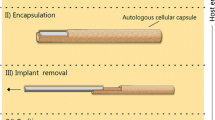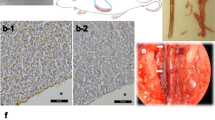Abstract
Synthetic vascular prostheses are foreign bodies, so that blood coagulation can occur on their luminal surfaces, causing graft occlusion very frequently in prostheses of small diameter. A vascular prosthesis needs angiogenesis for endothelialization of the luminal surface, as endothelial cells have natural and permanent antithrombogenic properties1. To induce capillary growth into the graft, we developed a method of transplanting bone marrow cells, which are primitive, strong enough to survive, and create blood cells, resulting in the inducement of capillary growth. In an animal experiment, marrow cells were infiltrated into the walls of long–fibril expanded polytetrafluoroethylene (ePTFE) vascular grafts. The grafts were implanted in the abdominal aortic position of 24 dogs autologously. Marrow cells survived and continued exogenous hemopoiesis for up to six months and were immunohistochemically reactive to basic fibroblast growth factor (bFCF). All the grafts older than three weeks had complete endothelialization and maintained their patency. Twenty grafts without bone marrow were implanted as controls. Endothelialization was present at anastomotic sites, but other areas were covered with fresh thrombi. Four out of seven control grafts were patent with endothelial cell lining at six months, but three were occluded and one of the four grafts was still covered with a thrombus layer. Bone marrow with its unique native properties produced autocrine angiogenicity in the graft.
Similar content being viewed by others
References
Burger, K., Sauvage, L.R., Rao, A.M. & Wood, S.J. Healing of arterial prostheses in man: Its incompleteness. Ann. Surg. 175, 118–127 (1972).
Golden, P.B., Sussman, I. & Hatcher, V.B. Long-term culture of human endothelial cells. In Vitro Cell Dev. Biol. 19, 661–671 (1983).
Sauvage, L.R. et al. A thin, porous, knitted arterial prosthesis: Experimental data and early clinical assessment. Surgery 65, 78–88 (1969).
Noishiki, Y., Tomizawa, Y., Yamane, Y. & Matsumoto, A. The vicious cycle of nonhealing neointima in fabric vascular prostheses. Artif. Organs 19, 7–16 (1995).
Clowes, A.W., Kirkman, T.R. & Clowes, M.M. Mechanisms of artificial graft healing: Rapid transmural capillary ingrowth provides a source of intimal endothelium and smooth muscle in porous PTFE prostheses. Am. J. Pathol. 123, 220–230 (1986).
Park, P.K. et al. Thrombus-free, human endothelial surface in the midregion of a Dacron vascular graft in the splanchnic venous circuit—observations after nine months of implantation. J. Vase. Surg. 11, 468–475 (1990).
Radomski, J.S., Jarrell, B.E., Pratt, K.J. & Williams, S.K. Effects of in vitro aging on human endothelial Cell adherence to Dacron vascular graft material. J. Surg. Res. 47, 173–177 (1989).
Noishiki, Y. et al. Acceleration of neointima formation in vascular prostheses by transplantation of autologous venous tissue fragments: Application to small-diameter grafts. J. Thorac. Cardiovasc. Surg. 105, 796–804 (1993).
Noishiki, Y. et al. Rapid endothelialization of vascular prostheses by seeding autologous venous tissue fragments. J. Thorac. Cardiovasc. Surg. 104, 770–778 (1992).
Noishiki, Y., Tomizawa, Y., Yamane, Y. & Matsumoto, A. Effectiveness of fragmented autologous adipose tissue as a sealer of porous textile grafts: Effect on endothelial development. J. Vase. Surg. 20, 279–287 (1994).
Rudolph, R. & Ballanthyne, D.L.Jr., Skin grafts. in Plastic Surgery, Vol. 1, General Principles, (eds McCarthy, J. G., May, J. W., Jr. & Littler, J. W. ) 221–274 (Saunders, Philadelphia, 1990).
Harkess, J.W., Ramsey, W.C., Harkess, J.W. Principles of fractures and dislocations in Rockwood and Greens Fractures in Adults (eds Rockwood, C.A., Jr., Green, D.P. & Bucholes, R.W. ) 145–180 (Lippincott, Philadelphia, 1991).
Wang, C.L. et al. Collagen-induced platelet aggregation and release. II. Critical size and structural requirements of collagen. Biochem. Biophys. Acta 68, 544–577 (1978).
Noishiki, Y., Yamane, Y., Tomizawa, Y. & Matsumoto, A. Transplantation of autologous tissue fragments into an e-PTFE graft with long fibrils. Artif. Organs 19, 17–26 (1995).
Fu, Y.M. et al. Acidic fibroblast growth factor in the developing rat embryo. J. Cell Biol. 114, 1261–1273 (1991).
Bikfalvi, A. & Han, Z.C. Angiogenic factors are hematopoietic growth factors and vice versa. Leukemia 8, 523–529 (1994).
Tilg, H., Trehu, E., Atkins, M.B., Dinarello, C.A. & Mier, J.W. Interleukin-6 (IL6) as an anti-inflammatory cytokine: Induction of circulating IL-1 receptor antagonist and soluble tumor necrosis factor receptor. Blood 83, 113–118 (1994).
Miwa, A.Y. et al. Salvage of infarcted myocardium by angiogenic action on basic fibroblast growth factor. Science 257, 1401–1403 (1992).
Bell, E., Ehrlich, H.P., Buttle, D.J. & Nakatsuji, T. Living tissue formed in vitro and accepted as skin-equivalent tissue of full thickness. Science 211, 1052–1054 (1981).
Guide for the Care and Use of Laboratory Animals. (National Institutes of Health, Bethesda, MD, NIH publ. no. 80-23, revised 1985).
Fu, Y.M. et. al. Acidic fibroblast growth factor in the developing rat embryo. J. Cell Biol. 114, 1261–1273 (1991).
Author information
Authors and Affiliations
Rights and permissions
About this article
Cite this article
Noishiki, Y., Tomizawa, Y., Yamane, Y. et al. Autocrine angiogenic vascular prosthesis with bone marrow transplantation. Nat Med 2, 90–93 (1996). https://doi.org/10.1038/nm0196-90
Received:
Accepted:
Issue Date:
DOI: https://doi.org/10.1038/nm0196-90
- Springer Nature America, Inc.
This article is cited by
-
A short discourse on vascular tissue engineering
npj Regenerative Medicine (2017)
-
Silk fibroin-Pellethane® cardiovascular patches: Effect of silk fibroin concentration on vascular remodeling in rat model
Journal of Materials Science: Materials in Medicine (2017)
-
Evaluation of endothelialization in the center part of graft using 3 cm vascular grafts implanted in the abdominal aortae of the rat
Journal of Artificial Organs (2017)
-
Regeneration of extrahepatic bile ducts by tissue engineering with a bioabsorbable polymer
Journal of Artificial Organs (2012)
-
Taking tissue engineering to heart
Nature Medicine (2011)





